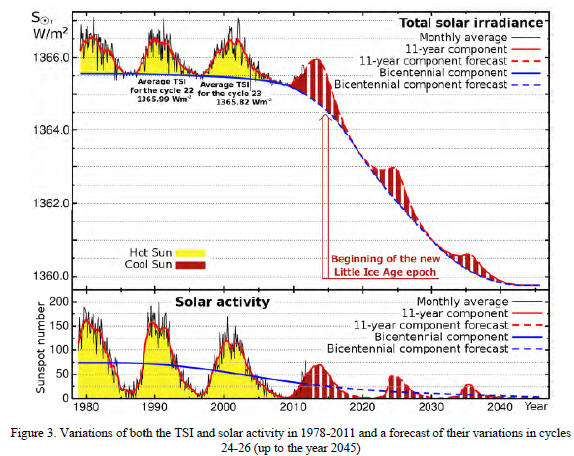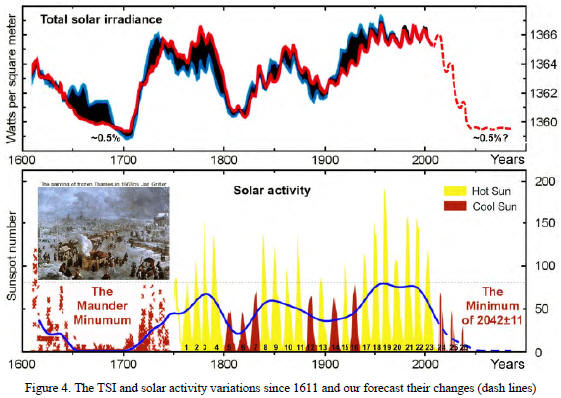|
from TheGlobalWarmingPolicyFoundation Website
The Little Ice Age Pulkovo Observatory of the Russian Academy of Science
St. Petersburg, 196140, Russia 1 February 2012
Abstract
That is why the debit and credit parts of the average annual energy budget of the terrestrial globe with its air and water envelope are practically always in an unbalanced state.
Average annual balance of the thermal budget of the system Earth-atmosphere during long time period will reliably determine the course and value of both an energy excess accumulated by the Earth or the energy deficit in the thermal budget which, with account for data of the TSI forecast, can define and predict well in advance the direction and amplitude of the forthcoming climate changes.
From early 90s we observe bicentennial decrease in both the TSI and the portion of its energy absorbed by the Earth.
The Earth as a planet will henceforward have negative balance in the energy budget which will result in the temperature drop in approximately 2014. Due to increase of albedo and decrease of the greenhouse gases atmospheric concentration the absorbed portion of solar energy and the influence of the greenhouse effect will additionally decline.
The influence of the consecutive chain of feedback effects which can lead to additional drop of temperature will surpass the influence of the TSI decrease.
The onset of the deep bicentennial minimum of TSI is expected in 2042±11, that of the 19th Little Ice Age in the past 7500 years - in 2055±11.
When the Sun’s surface was covered with sunspots, the wheat prices were going down. When the number of sunspots dropped the prices went up. He supposed that variations of wheat prices are the consequence of the corresponding climate changes.
However, he could not explain the physical nature of this phenomenon.
Later J.A. Eddy (1976) discovered the interconnection between clearly determined periods of significant variations of the sunspot activity level during the last millennium and corresponding deep climatic changes in both phase and amplitude.
During each of the eighteen deep minima of solar activity (of Maunder type) with a bicentennial cycle found in the preceding 7.5 millennia, deep cooling was observed, while during the periods of high maxima - global warming (Borisenkov, 1988).
Recent studies (Bal, et al. 2011; McPhaden, et al. 2011) confirm our results (Abdussamatov, 2009a, b) concerning a common action of eleven-year and bicentennial cyclic variations of the total solar irradiance (TSI - with some time-lag) on the change of state of the surface and subsurface layers (with the depth of tens and hundreds of meters) in the tropical part of the Pacific Ocean accompanied with appearance of warm or cold water (the cycles of La Niña or El Niño phenomena) which affects the climate change as well.
Observed characteristics of El Niño
during the last 31 years have been changing in the opposite
direction with regard to predictions of the climatic models assuming
predominant influence of the greenhouse gases.
Average value of TSI in the 23rd cycle was by 0.17 W/m2 less than in the 22nd cycle. Smoothed value of TSI in the minimum between the cycles 23/24 (1365.24 ± 0.02 W/m2) was by 0.26 W/m2 and by 0.33 W/m2 less than in the minima between cycles 22/23 and 21/22, respectively.
However, forming from early 1990s long-term deficit of TSI (see Fig. 2) was not compensated by decrease in the emission of the Earth intrinsic thermal energy into space which practically remains on the same high level during 14±6 years due to thermal inertia of the World Ocean.
Since the Sun is now entering a bicentennial long-term phase of low luminosity (e.g., Abdussamatov, 2004, 2005, 2007b; Penn and Livingston, 2010; American Astronomical Society, 2011) such energy imbalance of the system (E<0) will continue further for the next few 11-year cycles.
As a result, the Earth as a planet will henceforward have negative balance (E<0) in the energy budget.
This gradual consumption of solar energy
accumulated by the World Ocean during the whole XX century will
result in decrease of global temperature after 14±6 years because of
a negative balance in the energy budget of the Earth. This, in its
turn, will lead to the rise of Earth albedo, the drop of atmospheric
concentration of the most important greenhouse gas - water vapor, as
well as of carbon dioxide and other gases.
As a consequence, a portion of solar
radiation absorbed by the Earth will gradually go down together with
manifestations of the greenhouse effect caused by the secondary
feedback effects. The influence of the growing consecutive chain of
such changes will cause additional decrease of the global
temperature exceeding the effect of a bicentennial TSI decrease.
Under these circumstances the maximal smoothed for 13 months level of sunspot number in the cycles 24, 25 and 26 can reach 65±15, 45±20 and 30±20, respectively (Abdussamatov, 2007b, 2009a,b).
Hence, we can expect the onset of a deep bicentennial minimum of TSI in approximately 2042±11 and of the 19th deep minimum of global temperature in the past 7500 years - in 2055±11 (Fig. 4).
After the maximum of solar cycle 24, from approximately 2014 we can expect the start of the next bicentennial cycle of deep cooling with a Little Ice Age in 2055±11.
Thus, long-term variations of TSI (with
account for their direct and secondary, based on feedback effects,
influence) are the main fundamental cause of climate changes since
variations of the Earth climate is mainly determined by a long-term
imbalance between the energy of solar radiation entering the upper
layers of the Earth’s atmosphere and the total energy emitted from
the Earth back to space.
|



